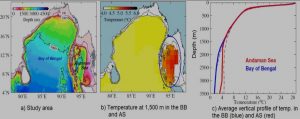Andaman Sea Warmer than the Bay of Bengal
INCOIS study reveals that the internal tide mixing keeps deep Andaman Sea warmer than the Bay of Bengal.
A new study conducted by Indian National Centre for Ocean Information Services (INCOIS) to investigate internal waves has solved a longstanding mystery about the role of oceanic processes in keeping the deep Andaman Sea (AS) warm. The study confirmed that deep waters (below 1,200 m) in the Andaman Sea are warmer (about 2°C) than that of the Bay of Bengal. The study is important to interpret the response of the ocean to climate change by understanding the distribution of temperature, both near the ocean surface and Deep Ocean.
keeping the deep Andaman Sea (AS) warm. The study confirmed that deep waters (below 1,200 m) in the Andaman Sea are warmer (about 2°C) than that of the Bay of Bengal. The study is important to interpret the response of the ocean to climate change by understanding the distribution of temperature, both near the ocean surface and Deep Ocean.
As per INCOIS, internal tide energy dissipation and associated vertical mixing play a major role in maintaining the warmer temperature in the deep Andaman Sea (AS). The rate of vertical mixing in the AS is about twice the magnitude than what is observed in the Bay of Bengal. This elevated internal tide induced vertical mixing results in the efficient transfer of heat into the deeper layers which keeps the deep Andaman Sea warm. Temperature distribution in the deep ocean plays an important role in regulating the deep ocean circulation, water mass formation, distribution of chemical properties as well as the distribution of marine organisms including invertebrate animals (that include sea anemones, sponges, corals, sea stars, sea urchins, worms, bivalves, crabs, and many more) life forms.
The scientist also noted that in addition to the small exchange of deep waters, higher temperature, which decreases the solubility of gases, also has contributed to the observed difference in the biogeochemical properties between Andaman Sea and Bay of Bengal.
Also Read : CMLRE study to help devise conservation strategy for Andaman and Nicobar Island ecosystems
Further, the higher concentration of dissolved Rare Earth Elements (REE) in the deep Andaman Sea compared to Bay of Bengal is attributed to the enhanced vertical mixing.
INCOIS study suggests that in future the amplitude of internal tides could be larger and Andaman Sea could have a more rapid response to the change in vertical mixing in the global warming scenario compared to other regions, therefore modeling and long-term measurements of physical, chemical and biological properties will be crucial in deciphering the long-term change in this region.
The scientists said that recent studies suggest that the effect of climate change is more pronounced in the deep sea and the marginal sea than previously believed. Under the global climate change scenario, tidal-induced deep-sea mixing plays an important role in controlling the distribution of heat and carbon in the ocean, helping drive global ocean circulation and force nutrients up from the deep, where they can be used by tiny plants at the sea surface that is at the base of the ocean’s food web.
Led by Jithin A.K., the research team comprised of Francis P. A. of INCOIS, Ministry of Earth Sciences. The research paper is published in Nature research/scientific reports. (India Science Wire)
